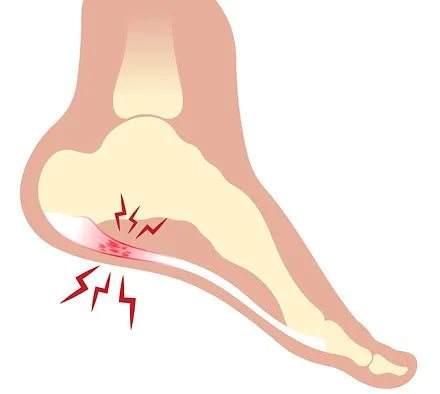Introduction:
Plantar fasciitis is a common foot condition that causes pain and discomfort in the heel and underside of the foot. It occurs when the plantar fascia, a thick band of tissue that runs along the bottom of the foot, becomes inflamed or irritated. While plantar fasciitis can be a result of various factors, understanding the key contributors to its development is crucial for prevention and treatment. In this blog post, we'll explore four factors that play a role in the development of plantar fasciitis.
1. Overuse and High-Impact Activities:
One of the primary factors contributing to plantar fasciitis is overuse or repetitive stress on the feet, particularly during high-impact activities such as running, jumping, or prolonged standing. Activities that involve repetitive pounding on hard surfaces can strain the plantar fascia, leading to micro-tears and inflammation. Over time, this repetitive stress can weaken the plantar fascia and increase the risk of developing plantar fasciitis. To prevent overuse injuries, it's important to gradually increase the intensity and duration of physical activities, wear supportive footwear, and incorporate rest and recovery periods into your routine.
2. Improper Footwear and Biomechanical Factors:
Wearing shoes that lack proper support or don't provide adequate cushioning can also contribute to the development of plantar fasciitis. Shoes with insufficient arch support or worn-out soles can alter the biomechanics of the foot, causing excessive strain on the plantar fascia and surrounding structures. Additionally, factors such as flat feet, high arches, or abnormal foot mechanics can increase the risk of developing plantar fasciitis. Addressing biomechanical issues with supportive footwear, orthotic inserts, or physical therapy can help alleviate strain on the plantar fascia and reduce the risk of injury.
3. Tightness and Weakness in the Lower Body Muscles:
Tightness and weakness in the muscles of the lower body, including the calves, hamstrings, and Achilles tendon, can contribute to imbalances in the feet and ankles, leading to increased stress on the plantar fascia. Tight calf muscles, in particular, can pull on the Achilles tendon and plantar fascia, causing tension and irritation. Similarly, weakness in the muscles that support the arch of the foot can result in excessive pronation (rolling inward) or supination (rolling outward), which can strain the plantar fascia. Incorporating stretching and strengthening exercises for the lower body into your fitness routine can help improve flexibility and stability, reducing the risk of plantar fasciitis.
4. Obesity and Excess Body Weight:
Excess body weight places additional stress on the feet and can increase the risk of developing plantar fasciitis. The added pressure from carrying extra weight can strain the plantar fascia and exacerbate inflammation and pain in the heel and arch of the foot. Furthermore, obesity can contribute to biomechanical issues such as overpronation or flat feet, which can further increase the risk of plantar fasciitis. Maintaining a healthy weight through a balanced diet and regular exercise can help alleviate pressure on the feet and reduce the likelihood of developing plantar fasciitis.
Conclusion:
Plantar fasciitis is a common foot condition that can cause significant pain and discomfort if left untreated. By understanding the factors that contribute to its development, you can take proactive steps to prevent injury and promote foot health. Whether it's through proper footwear, stretching and strengthening exercises, or maintaining a healthy weight, addressing these factors can help reduce the risk of plantar fasciitis and keep your feet happy and pain-free. If you're experiencing persistent foot pain or suspect you may have plantar fasciitis, consult with a healthcare professional for diagnosis and treatment options tailored to your needs.

